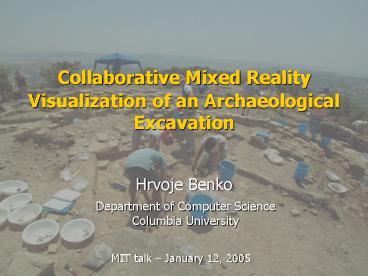Collaborative Mixed Reality Visualization of an Archaeological Excavation PowerPoint PPT Presentation
1 / 34
Title: Collaborative Mixed Reality Visualization of an Archaeological Excavation
1
Collaborative Mixed Reality Visualization of an
Archaeological Excavation
- Hrvoje Benko
Department of Computer ScienceColumbia University
MIT talk January 12, 2005
2
Multidisciplinary Team
3
Motivation
- Excavation is destructive and physically
unreconstructable process - Need to preserve as much data as possible for
analysis - Data interpretation happens off-site
- Current tools focus on 2D data and do not
incorporate 3D information - Many expertscollaboration is a must!
4
Archaeological Excavation at Monte Polizzo,
Sicily, Summer 2003Ian Morris, Director
(Stanford University)
5
Working in the field!
6
Meshed 3D Model (13 scans)
7
We have a 3D site model, now what?
Real
Virtual
8
(No Transcript)
9
(No Transcript)
10
Two Problems
- How to combine all this data in one seamless
environment? - How to make it easy to interact with?
11
VITA Visual Interaction Tool for Archaeology
- Multiple users
- Multiple displays
- Projected tabletop
- Handheld
- High-resolution monitor
- See-through head-worn
- Multiple interaction devices
- MERL DiamondTouch table
- EssentialReality P5 gloves
- Speech input
- 6DOF tracker
12
Design Considerations
- Use the most appropriate display for the given
data - Facilitate both human-system and human-human
interaction
13
Modular Architecture
14
AR Module Components
Sony Head-Worn Display (LDI-D100B)
Head Tracker Hand Tracker (Intersense IS900)
Microphone
P5 Glove (Essential Reality)
DiamondTouch Table Connector (MERL)
15
Life-size Immersive Exploration
16
3D Multimodal Interaction
- Provide natural interaction mechanism for our 3D
environment - Modalities
- Speech IBM ViaVoice 10
- Gestures EssentialReality P5 glove
- Selection statistics SenseShapes
- Focus on selection
- Based on collaboration with Phil Cohen et al.
(ICMI 2003) and SenseShapes (ISMAR 2003)
17
VirtualTray
18
Desktop Components
High-resolution Display
Touch-sensitive Projective Display (MERL
DiamondTouch)
Handheld Display
19
World-In-Miniature
20
Harris Matrix
21
Enhanced Harris Matrix
22
Enhanced Harris Matrix
23
Cross-Dimensional Hybrid Gestures
- Synchronized 2D and 3D gestures
- Facilitate seamless transition across dimensions
To appear in IEEE VR 2005
24
Cross-Dimensional Hybrid Gestures
PullPush
To appear in IEEE VR 2005
25
Cross-Dimensional Hybrid Gestures
PullPinDragRotate Push
To appear in IEEE VR 2005
26
Cross-Dimensional Hybrid Gestures
PullConnectScaleDisconnect Push
To appear in IEEE VR 2005
27
Handheld Focus-in-Context Display
- Movable high-resolution inset
- Tracked by DiamondTouch
- Projection suppressed in its bounds
- Physical magic lens
28
Tabletop Interaction
29
User Feedback
- Overall very positive reaction
- Archaeologists benefited from
- TemporalSpatial connection
- Aggregated collection of all data
- Accurate 3D model
- Simple touch-based interactions
- Potential for increased collaboration
30
Room for Improvement
- Reduce wires
- Reduce weight
- Eye occlusion hinders communication
- Missing data
- More objects, features, notes and pictures
- More scans during excavation (time-lapse spatial
record) - Missing features
- Virtual scale measure (implemented since)
- Variable site model scaling
- Improved selection in world-in-miniature
31
Current and Future Work
- Larger Site
- Summer 2004 - Thulamela, South Africa
- Personalized user experience based on expertise
- Environment management
32
Acknowledgments
- Special thanks to
- Peter Allen, Alejandro Troccoli, and Ben Smith
(CU Robotics Lab) - Ian Morris and Trinity Jackman (Stanford
Archaeology Center) - Lynn Meskell and James Conlon (CU Dept. of
Archaeology) - Sajid Sadi and Avinanindra Utukuri (P5 glove)
- Shezan Baig
- Mitsubishi Electric Research Labs (DiamondTouch
table) - Alias Systems
- Microsoft Research
- Funded in part by NSF ITR Grants IIS-0121239 and
IIS-00-82961, and Office of Naval Research
Contracts N00014-99-1- 0394, N00014-99-1-0683,
N00014-99-1-0249, and N00014-04-1-0005.
33
Questions?
34
(No Transcript)

